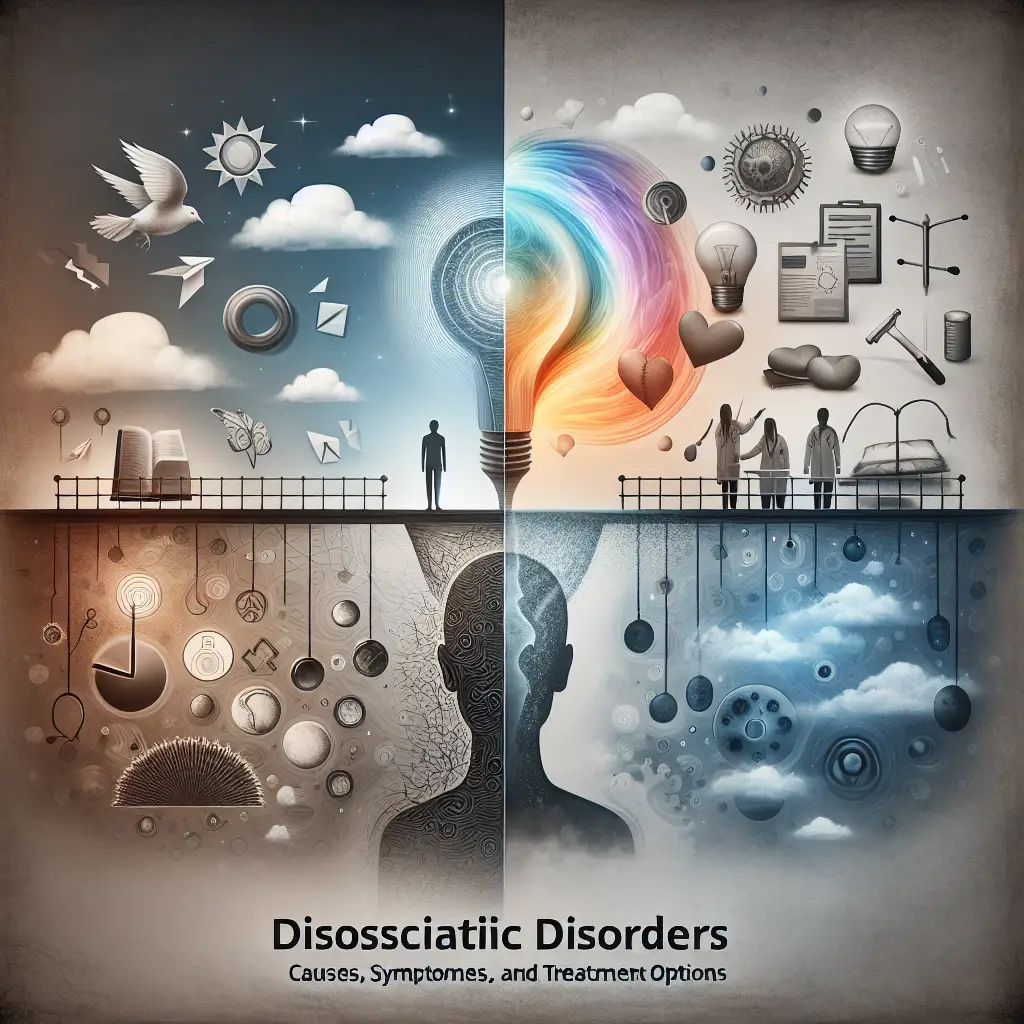
Understanding Dissociative Disorders: Causes, Symptoms, and Treatment Options—Your Essential Guide
Introduction
Imagine waking up and not recognizing where you are, or feeling detached from your own body as if you are merely an observer in your own life. This unsettling experience isn’t fiction; it’s a reality for many individuals living with dissociative disorders. According to recent studies, dissociative disorders are more common than previously thought, affecting a significant portion of the population. Yet, many remain unaware of the complexities surrounding these conditions. In this comprehensive guide, we delve into the intricacies of dissociative disorders, providing valuable insights into their causes, symptoms, and treatment options.
Understanding dissociative disorders can foster empathy and create supportive environments for those affected. It is crucial to shed light on this often misunderstood area in a world that is becoming more open to discussing mental health. This article aims to unravel the threads of dissociative disorders, offering clarity and hope for individuals seeking to understand their experiences more profoundly.
What are Dissociative Disorders?
Dissociative disorders are a group of mental health disorders that involve a disruption in the normal integration of consciousness, memory, identity, or perception. This disruption often manifests as a way for individuals to cope with stress or trauma, leading them to dissociate from their thoughts and feelings to avoid emotional pain.
Types of Dissociative Disorders
-
- Dissociative Identity Disorder (DID): Formerly known as multiple personality disorder, DID is characterized by the presence of two or more distinct personality states or identities, each with its own patterns of perceiving, relating to, and thinking about the world.
-
- Dissociative Amnesia: This disorder involves an inability to recall important autobiographical information, usually related to a traumatic or stressful event. The memory loss is more extensive than ordinary forgetfulness.
-
- Depersonalization/Derealization Disorder: Individuals with this disorder experience persistent or recurrent feelings of detachment from their own body (depersonalization) or feelings of unreality or detachment from their surroundings (derealization).
Prevalence of Dissociative Disorders
While exact figures are challenging to establish, studies estimate that approximately 1-3% of the population may experience dissociative disorders at some point in their lives. This statistic highlights the necessity for increased awareness and understanding of these complex conditions.
Understanding the Causes of Dissociative Disorders
Dissociative disorders often arise as a coping mechanism in response to extreme stress or trauma. Understanding dissociative disorders’ causes involves exploring the intersection of psychological, biological, and environmental factors.
Trauma and Stress
-
- Childhood Adversities: Many individuals with dissociative disorders have a history of severe trauma, especially during childhood. Experiences such as emotional, physical, or sexual abuse can lead to dissociation as a protective measure.
-
- Severe Stressors: Events such as natural disasters, severe accidents, or the sudden loss of a loved one can also trigger dissociative symptoms.
Psychological Factors
-
- Personality Traits: Some studies suggest that individuals with certain personality traits, such as high suggestibility, may be more prone to dissociative experiences.
-
- Coping Mechanisms: Dissociation can act as a coping strategy to manage overwhelming emotions or painful memories, allowing individuals to distance themselves from their distress.
Biological Influences
Emerging research indicates that there may be biological underpinnings to dissociative disorders. Brain imaging studies have shown differential activity in brain regions responsible for processing trauma and stress, suggesting a neurobiological basis for dissociative symptoms.
Symptoms of Dissociative Disorders
The symptoms of dissociative disorders can vary significantly between individuals and depend on the specific type of disorder. However, some common symptoms may include:
Symptoms of Dissociative Identity Disorder (DID)
-
- Amnesia concerning personal information or events
-
- Sudden changes in identity, including distinct names, personal history, and characteristics
-
- Gaps in memory that differ from ordinary forgetfulness
-
- Out-of-body experiences
Symptoms of Dissociative Amnesia
-
- Inability to recall important autobiographical information, usually related to trauma
-
- Memory loss that may last for hours, days, or longer
-
- Confusion regarding personal identity
Symptoms of Depersonalization/Derealization Disorder
-
- Feeling detached from one’s body or thoughts (depersonalization)
-
- A sense of unreality regarding one’s surroundings (derealization)
-
- Emotional and physical numbness
Table: Symptoms Overview
| Disorder | Key Symptoms |
|---|---|
| Dissociative Identity Disorder (DID) | Memory gaps, identity changes, out-of-body experiences |
| Dissociative Amnesia | Inability to recall personal memories |
| Depersonalization/Derealization | Feelings of detachment from self/surroundings |
Case Studies: Real-World Applications
Case Study 1: Laura – A Journey Through DID
Laura, a 28-year-old woman, was diagnosed with Dissociative Identity Disorder after years of struggling with unexplained memory gaps and emotional outbursts. Through therapy, she learned that her dissociative identities emerged as a response to childhood trauma. By understanding her condition, Laura found a supportive therapist who guided her through a process of integration and healing.
Analysis: Laura’s story illustrates the complexity of DID and how understanding dissociative disorders can lead to effective treatment. Her experience reinforces the importance of trauma-informed care in mental health treatment.
Case Study 2: Mark – Overcoming Dissociative Amnesia
Mark, a 35-year-old man, experienced significant gaps in memory following a car accident. Unable to recall details of the incident or his previous life, he sought therapy for assistance. Through memory retrieval techniques and gradual exposure to the stressful event, Mark slowly began to recover his lost memories and rebuild his sense of identity.
Analysis: Mark’s case highlights the often traumatic nature of dissociative amnesia and the need for patience and empathy in treatment. Understanding dissociative disorders allows therapists to tailor their approaches to better serve their clients.
Treatment Options for Dissociative Disorders
Treating dissociative disorders can be a complex process, and there’s no one-size-fits-all approach. Here are several effective treatment options that emerge when understanding dissociative disorders, their causes, symptoms, and treatment options.
Psychotherapy
-
- Cognitive Behavioral Therapy (CBT): This method helps individuals identify and change negative thought patterns and behaviors associated with dissociative disorders.
-
- Dialectical Behavior Therapy (DBT): Particularly useful for individuals struggling with emotional regulation, DBT combines cognitive and behavioral techniques with mindfulness practices.
-
- Trauma-Focused Therapy: Addressing the root causes of dissociation is crucial. Therapists trained in trauma-informed care can guide clients to process their trauma in a safe environment.
Medication
While there are no specific medications for dissociative disorders, antidepressants and anti-anxiety medications can help manage co-occurring symptoms such as depression and anxiety.
Support Groups
Joining support groups allows individuals to connect with others who share similar experiences, fostering a sense of community and understanding.
Mindfulness and Grounding Techniques
Practices such as mindfulness, yoga, and grounding techniques can help individuals reconnect with their bodies and surroundings, reducing dissociative symptoms in the moment.
Conclusion
Understanding dissociative disorders – their causes, symptoms, and treatment options – is a critical step toward fostering a more empathetic society. While the road to recovery can be daunting, it’s essential to know that healing is possible. By combining therapy, community support, and self-care practices, individuals can learn to navigate their experiences and reclaim their identities.
As we become more aware of dissociative disorders, we create opportunities for open dialogue and mutual support. Let us strive to understand and embrace one another’s experiences, breaking down the stigma surrounding mental health issues. After all, knowledge is a powerful tool for healing.
FAQs
1. What is the difference between dissociative identity disorder and dissociative amnesia?
The key difference lies in how the disorders manifest:
- Dissociative Identity Disorder (DID):
- Characterized by the presence of two or more distinct identities or personality states that control the individual’s behavior at different times.
- Often accompanied by memory gaps beyond ordinary forgetfulness, such as not recalling events when another identity was dominant.
- Dissociative Amnesia:
- Involves an inability to recall important personal information, typically related to trauma or stress.
- Does not involve multiple identities; instead, the person may have localized amnesia (forgetting a specific event) or generalized amnesia (forgetting one’s entire identity).
Both are dissociative disorders but differ in their core features and presentation.
2. Can dissociative disorders be treated effectively?
Yes, dissociative disorders can be effectively treated with appropriate interventions:
- Psychotherapy:
- Techniques like cognitive-behavioral therapy (CBT) or dialectical behavior therapy (DBT) help individuals address trauma and learn coping strategies.
- Specialized approaches, such as trauma-focused therapy, are often used for DID.
- Medication:
- While no medication directly treats dissociative disorders, antidepressants or anti-anxiety medications can alleviate associated symptoms like depression or anxiety.
- Support Groups and Peer Support:
- Connecting with others who have similar experiences fosters understanding and resilience.
Early diagnosis and consistent treatment improve outcomes significantly.
3. How common are dissociative disorders?
Dissociative disorders are relatively common, though underdiagnosed. Studies indicate:
- They affect approximately 1-3% of the general population during their lifetime.
- Higher prevalence rates are seen in individuals with histories of trauma, abuse, or neglect.
- Women are more frequently diagnosed, possibly due to differences in how symptoms present or are reported.
Despite being more common than previously believed, dissociative disorders often go unrecognized due to stigma or lack of awareness.
4. Are there any physical symptoms associated with dissociative disorders?
Yes, individuals with dissociative disorders may experience physical symptoms, often linked to emotional distress or psychological factors. These include:
- Headaches
- Dizziness or a sense of disorientation
- Fatigue
- Digestive Issues
- Unexplained Pain
These symptoms can be psychosomatic, meaning they arise from mental distress rather than a physical condition. Addressing the underlying emotional issues often alleviates these physical symptoms.
5. What should I do if I think I have a dissociative disorder?
If you suspect you have a dissociative disorder, follow these steps:
- Seek Professional Help:
- Consult a mental health professional, such as a psychologist or psychiatrist, for a comprehensive evaluation.
- Document Symptoms:
- Keep a journal of your experiences, including memory gaps, feelings of detachment, or other unusual symptoms, to provide detailed information to your clinician.
- Educate Yourself:
- Learn about dissociative disorders to better understand your experiences and engage actively in treatment.
- Access Support:
- Reach out to trusted friends, family, or support groups for emotional backing.
Timely diagnosis and treatment can significantly improve quality of life and mental well-being.
In your quest to navigate the complexities of dissociative disorders, remember that understanding is the first step toward compassion and recovery. Knowing more empowers us to promote healthier conversations about mental health, whether it’s for ourselves or someone we care about.

















